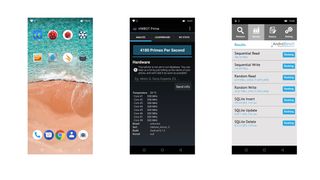Why you can trust TechRadar
In use
The Ulefone Armor 5 is a pleasure to use because unlike many chunky rugged phones, it is slim enough to fit in your pocket and the 18.9:9 aspect ratio makes it easier to operate with one hand. It starts up quickly enough although for whatever reason, it always takes multiple attempts to read a fingerprint. Face ID is often faster for this reason, but you could also sign into Android with a gesture, or a password.

Here’s how the Ulefone Armor 5 performed in our suite of benchmark tests:
Geekbench: 805 (single-core); 2,288 (multi-core); 2,713 (compute)
Antutu: 80,380
PCMark (Work 2.0): 4,801
Passmark: 4,264
Passmark CPU: 98,883
Androbench (sequential): 286 (sequential read); 247 (sequential write)
Androbench (random): 64 (random read); 21 (random write)
3DMark Slingshot: 689
3DMark Slingshot Extreme: 443
3DMark IceStorm: 7,756
HWBot Prime: 4,180
Apps run smoothly, even when toggling between demanding graphics-heavy games. As a gaming device, it works very well, especially as the 18.9:9 screen divides evenly into a split screen for 3D games. And for workers who need a tough handset, the Ulefone Armor 5 is also a good choice. It doesn’t look as well protected as the Blackview BV5800 Pro, for example, but when we threw the Armor 5 around in the same way, it didn’t show any sign of failing and it is no less water resistant either.
It is a pity there’s no function button, but the feature set seems well specified for outdoor situations with Face ID allowing you to sign in without having to remove your gloves and a battery that lives up to its claim of ten hours of uninterrupted video playback.
Call quality is fine and finding a signal is rarely a problem when you have two SIM cards and global coverage, but the external speaker is rather feeble. Image quality on the display is limited to 720p, but for most purposes, it looks sharp enough and the haptic touchscreen is sensitive, although not sensitive enough to work with gloved fingers.
Final verdict
Given the bargain basement price point, this tough phone performed well and feels as though it is tough enough to take to a building site. OK, so it probably wouldn’t survive a direct hit from a house brick, but the metal and rubber bezel seems as strong as the next rugged phone and this one has the advantage of actually fitting in your pocket.
It has a fast enough CPU to make Android 8.1 Oreo look good, a decent dual-lens camera and, thanks to the notch, a surprisingly large screen. Sure, it could have been a Full HD screen and the CPU could have been faster, but we think Ulefone made the right decision in keeping the cost down and making sure the essentials, like a USB-C port and a big battery are on the spec sheet.
- We've also highlighted the best rugged phones of 2018
Jim is a seasoned expert when it comes to testing tech. From playing a prototype PlayStation One to meeting a man called Steve about a new kind of phone in 2007, he’s always hunting the next big thing at the bleeding edge of the electronics industry. After editing the tech section of Wired UK magazine, he is currently specialising in IT and voyaging in his VW camper van.


